Detailed Analysis of Financial Reporting for Decision Making
VerifiedAdded on 2023/04/11
|11
|774
|201
Report
AI Summary
This report provides an overview of financial reporting, emphasizing its importance in today's complex business environment. It outlines the key purposes of financial reporting, including assessing an entity's performance in both financial and non-financial terms, such as revenue, expenditure, and corporate social responsibility. The report also details the significance of financial position disclosures, covering control over financial structure, resource details, and liquidity aspects. Furthermore, it examines the role of financial reporting in financing and investing activities, highlighting how stakeholders can understand fund procurement and investment strategies. Finally, the report addresses the compliance activities, ensuring that the entity adheres to all rules and regulations, as per the NZ Conceptual framework, thereby providing a comprehensive understanding of financial reporting's role in decision-making and stakeholder communication.
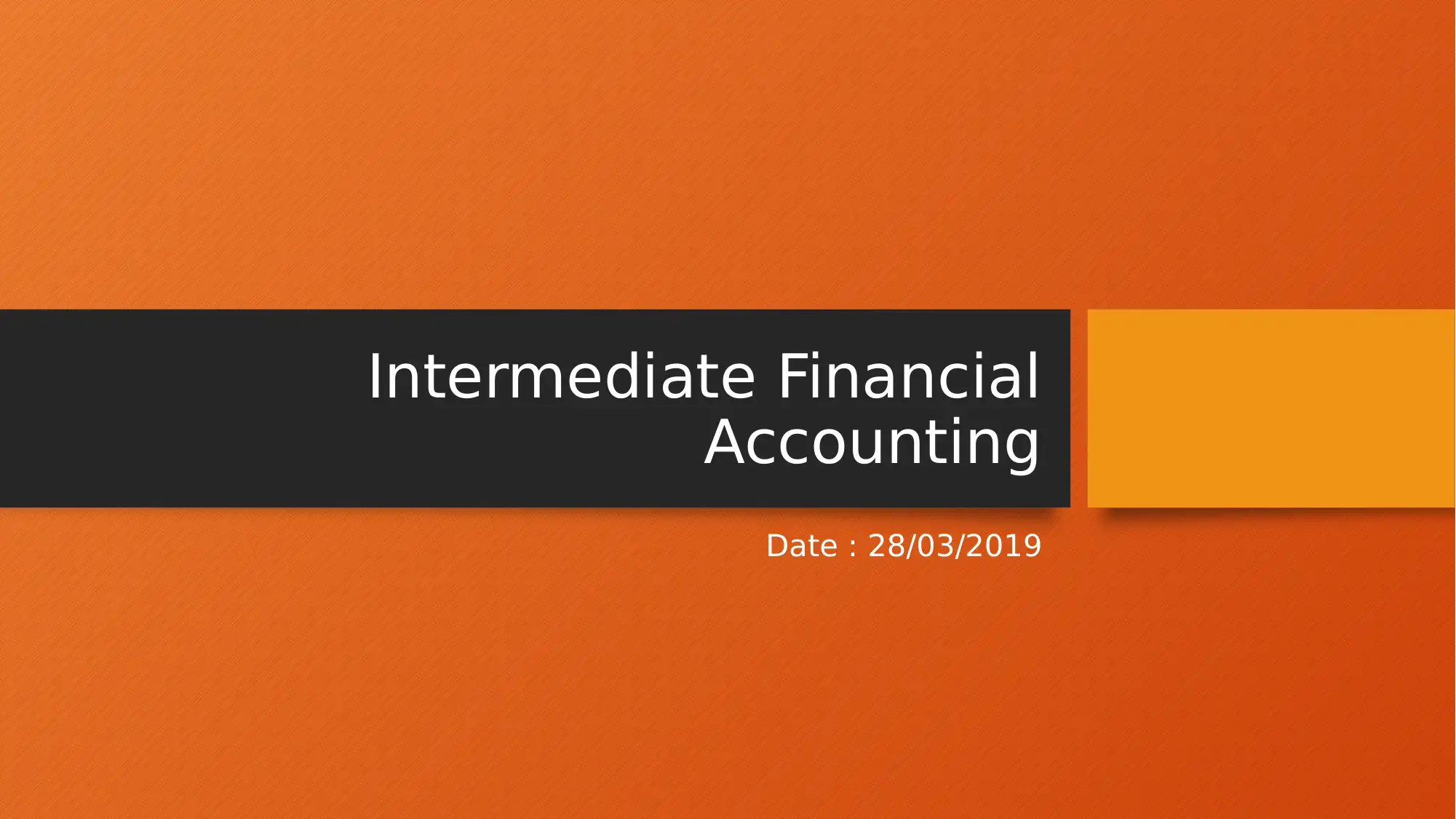
Intermediate Financial
Accounting
Date : 28/03/2019
Accounting
Date : 28/03/2019
Paraphrase This Document
Need a fresh take? Get an instant paraphrase of this document with our AI Paraphraser

Student Name:
Professor Name:
University Name:
Course Name:
Date : 28/03/2019
Professor Name:
University Name:
Course Name:
Date : 28/03/2019
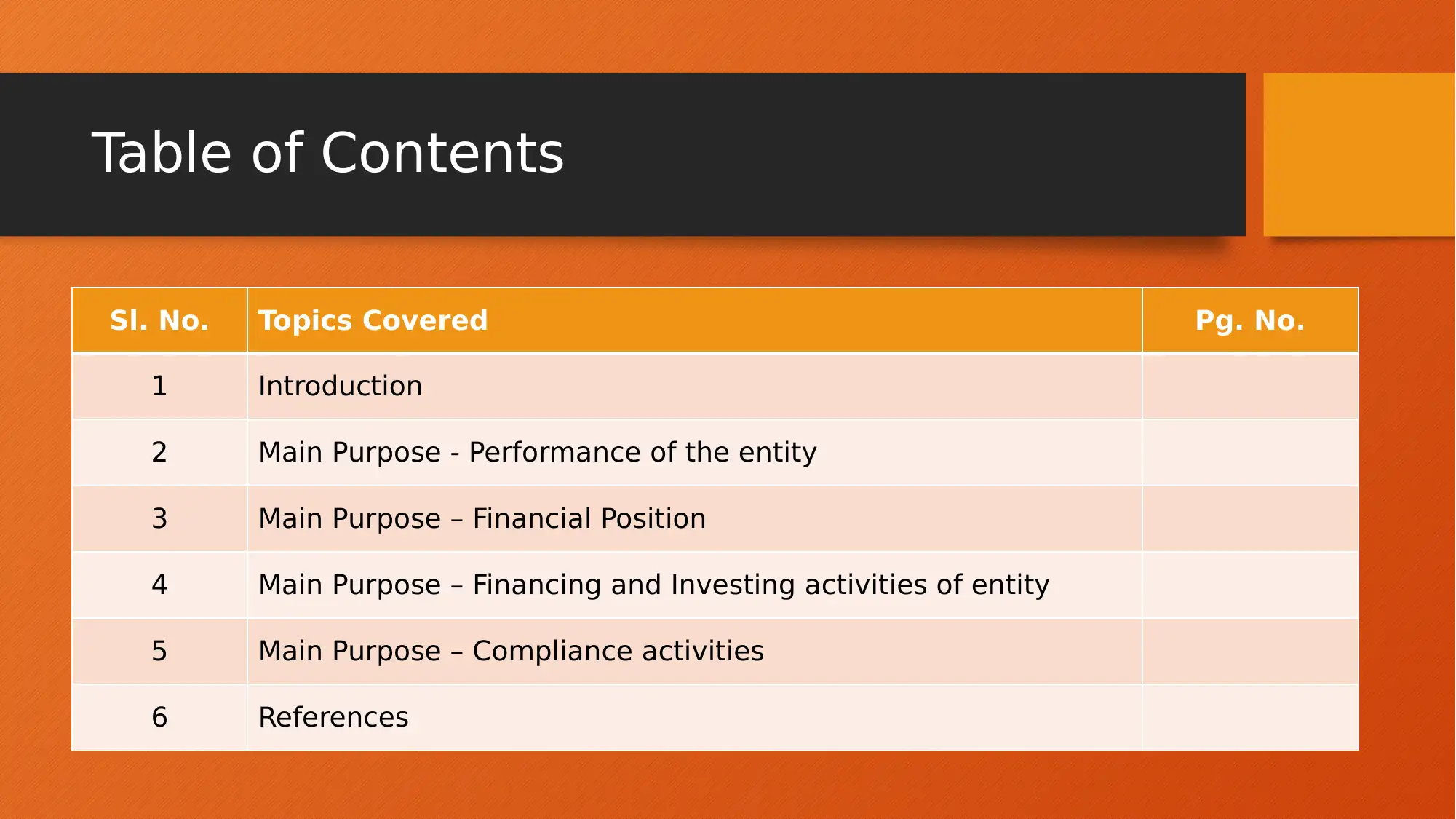
Table of Contents
Sl. No. Topics Covered Pg. No.
1 Introduction
2 Main Purpose - Performance of the entity
3 Main Purpose – Financial Position
4 Main Purpose – Financing and Investing activities of entity
5 Main Purpose – Compliance activities
6 References
Sl. No. Topics Covered Pg. No.
1 Introduction
2 Main Purpose - Performance of the entity
3 Main Purpose – Financial Position
4 Main Purpose – Financing and Investing activities of entity
5 Main Purpose – Compliance activities
6 References
⊘ This is a preview!⊘
Do you want full access?
Subscribe today to unlock all pages.

Trusted by 1+ million students worldwide
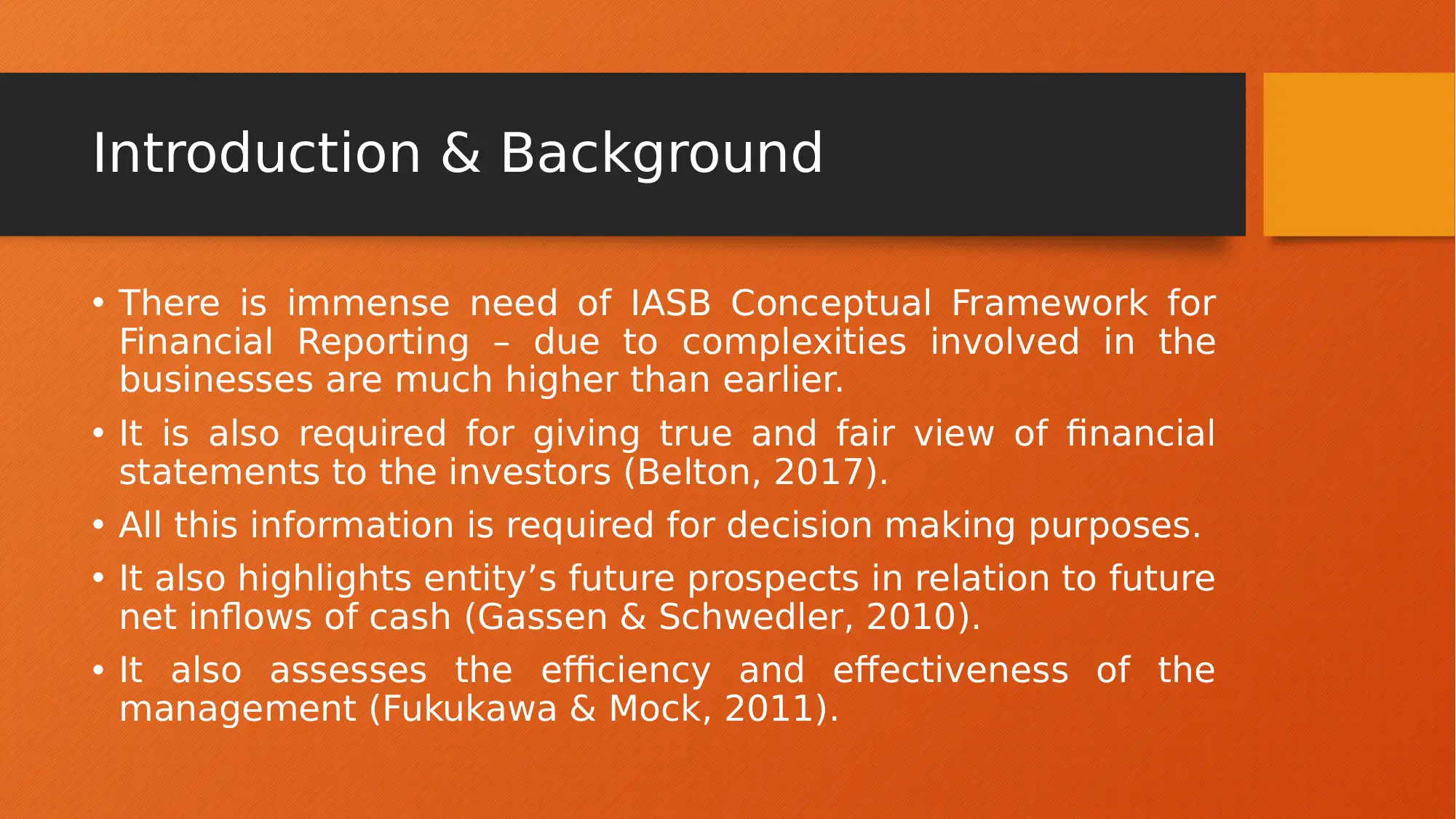
Introduction & Background
• There is immense need of IASB Conceptual Framework for
Financial Reporting – due to complexities involved in the
businesses are much higher than earlier.
• It is also required for giving true and fair view of financial
statements to the investors (Belton, 2017).
• All this information is required for decision making purposes.
• It also highlights entity’s future prospects in relation to future
net inflows of cash (Gassen & Schwedler, 2010).
• It also assesses the efficiency and effectiveness of the
management (Fukukawa & Mock, 2011).
• There is immense need of IASB Conceptual Framework for
Financial Reporting – due to complexities involved in the
businesses are much higher than earlier.
• It is also required for giving true and fair view of financial
statements to the investors (Belton, 2017).
• All this information is required for decision making purposes.
• It also highlights entity’s future prospects in relation to future
net inflows of cash (Gassen & Schwedler, 2010).
• It also assesses the efficiency and effectiveness of the
management (Fukukawa & Mock, 2011).
Paraphrase This Document
Need a fresh take? Get an instant paraphrase of this document with our AI Paraphraser
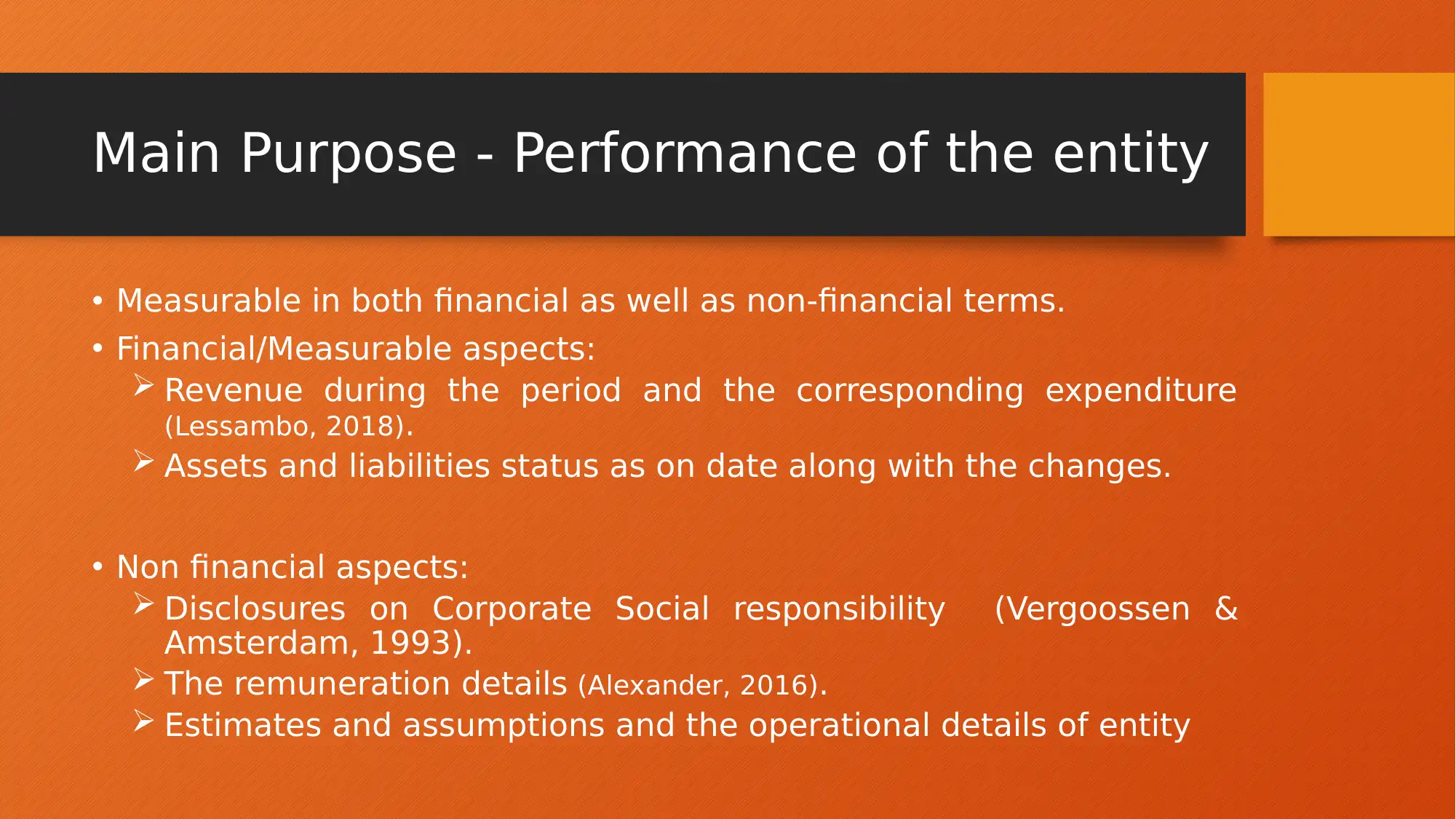
Main Purpose - Performance of the entity
• Measurable in both financial as well as non-financial terms.
• Financial/Measurable aspects:
Revenue during the period and the corresponding expenditure
(Lessambo, 2018).
Assets and liabilities status as on date along with the changes.
• Non financial aspects:
Disclosures on Corporate Social responsibility (Vergoossen &
Amsterdam, 1993).
The remuneration details (Alexander, 2016).
Estimates and assumptions and the operational details of entity
• Measurable in both financial as well as non-financial terms.
• Financial/Measurable aspects:
Revenue during the period and the corresponding expenditure
(Lessambo, 2018).
Assets and liabilities status as on date along with the changes.
• Non financial aspects:
Disclosures on Corporate Social responsibility (Vergoossen &
Amsterdam, 1993).
The remuneration details (Alexander, 2016).
Estimates and assumptions and the operational details of entity
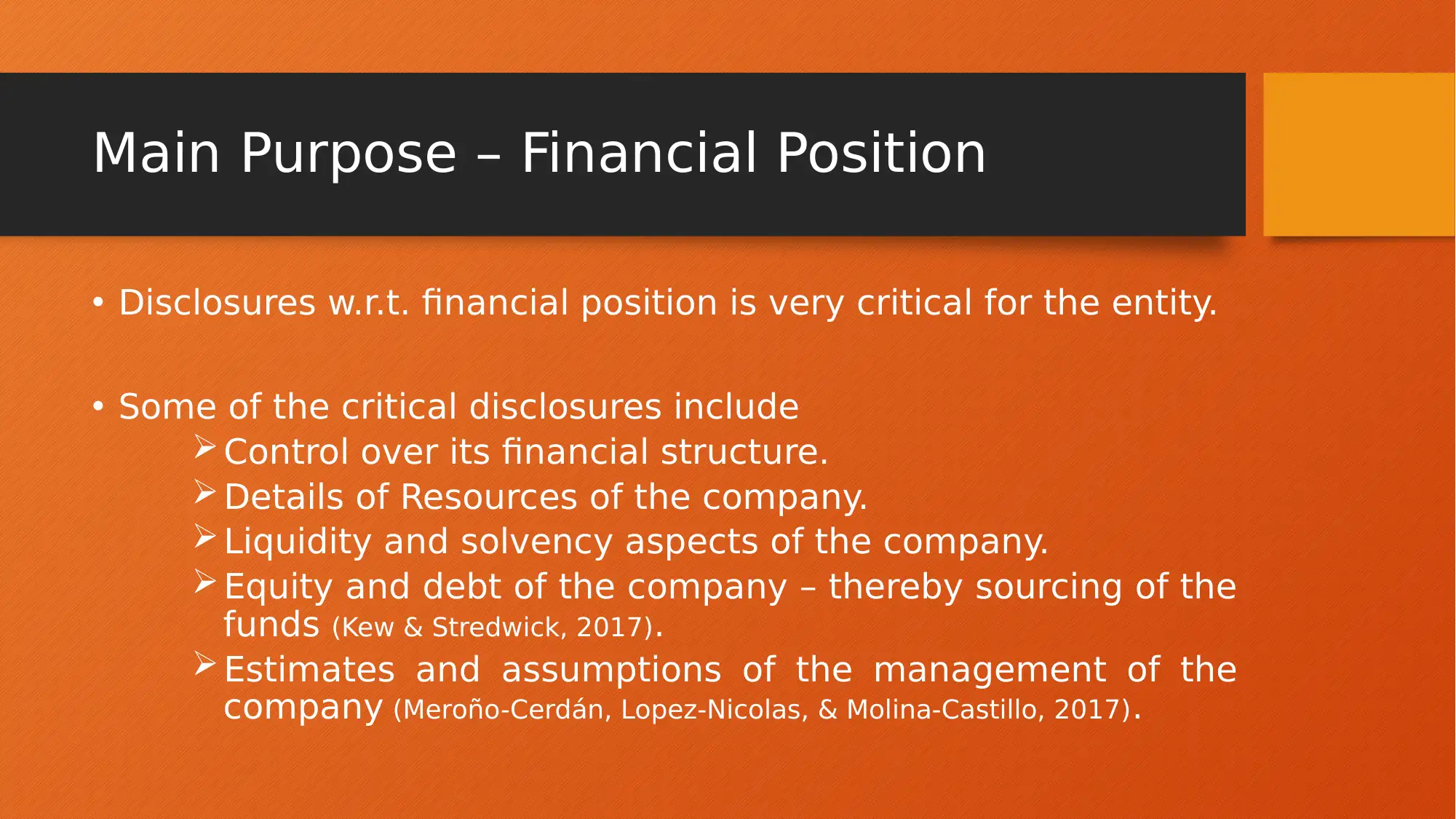
Main Purpose – Financial Position
• Disclosures w.r.t. financial position is very critical for the entity.
• Some of the critical disclosures include
Control over its financial structure.
Details of Resources of the company.
Liquidity and solvency aspects of the company.
Equity and debt of the company – thereby sourcing of the
funds (Kew & Stredwick, 2017).
Estimates and assumptions of the management of the
company (Meroño-Cerdán, Lopez-Nicolas, & Molina-Castillo, 2017).
• Disclosures w.r.t. financial position is very critical for the entity.
• Some of the critical disclosures include
Control over its financial structure.
Details of Resources of the company.
Liquidity and solvency aspects of the company.
Equity and debt of the company – thereby sourcing of the
funds (Kew & Stredwick, 2017).
Estimates and assumptions of the management of the
company (Meroño-Cerdán, Lopez-Nicolas, & Molina-Castillo, 2017).
⊘ This is a preview!⊘
Do you want full access?
Subscribe today to unlock all pages.

Trusted by 1+ million students worldwide
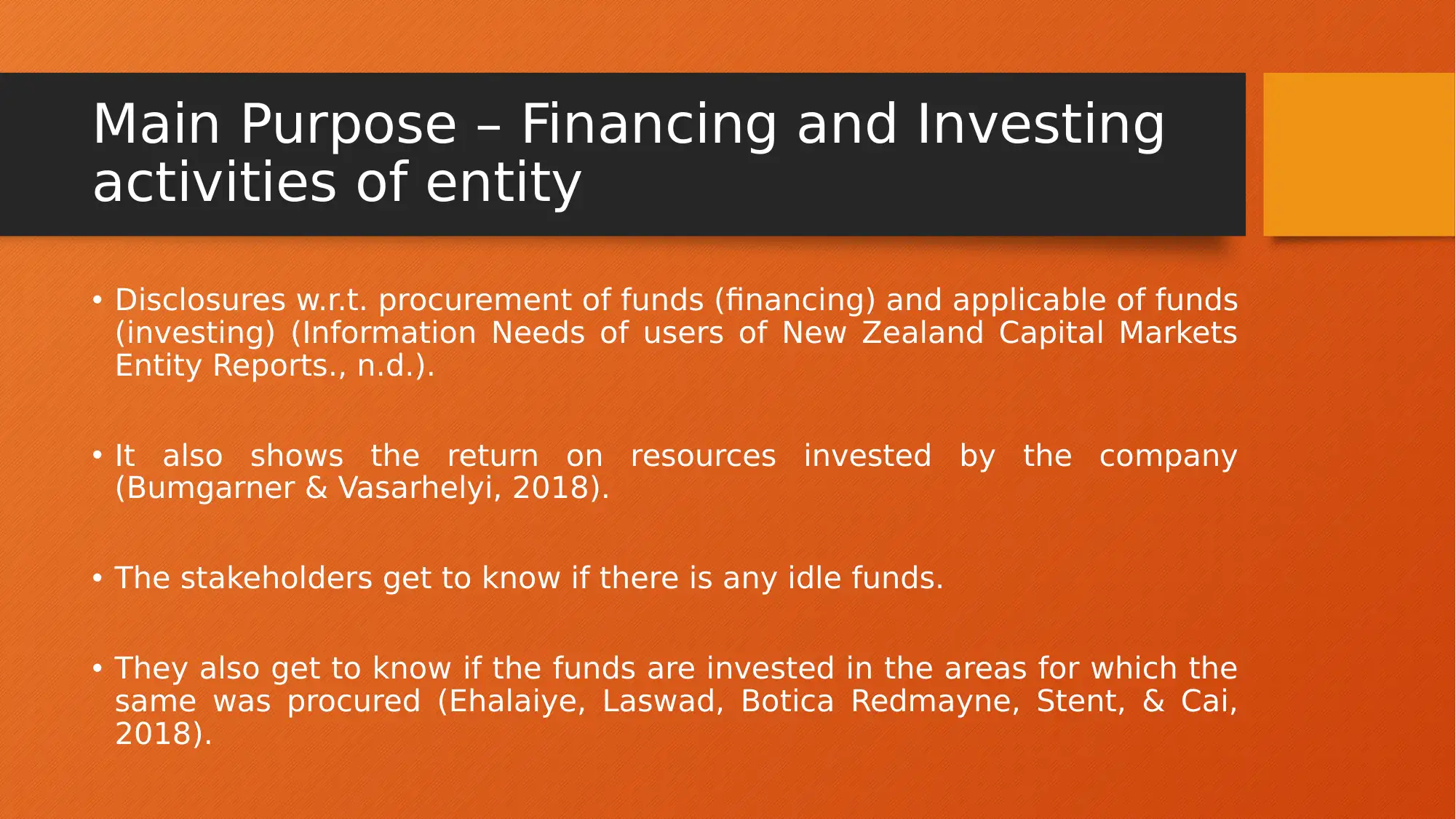
Main Purpose – Financing and Investing
activities of entity
• Disclosures w.r.t. procurement of funds (financing) and applicable of funds
(investing) (Information Needs of users of New Zealand Capital Markets
Entity Reports., n.d.).
• It also shows the return on resources invested by the company
(Bumgarner & Vasarhelyi, 2018).
• The stakeholders get to know if there is any idle funds.
• They also get to know if the funds are invested in the areas for which the
same was procured (Ehalaiye, Laswad, Botica Redmayne, Stent, & Cai,
2018).
activities of entity
• Disclosures w.r.t. procurement of funds (financing) and applicable of funds
(investing) (Information Needs of users of New Zealand Capital Markets
Entity Reports., n.d.).
• It also shows the return on resources invested by the company
(Bumgarner & Vasarhelyi, 2018).
• The stakeholders get to know if there is any idle funds.
• They also get to know if the funds are invested in the areas for which the
same was procured (Ehalaiye, Laswad, Botica Redmayne, Stent, & Cai,
2018).
Paraphrase This Document
Need a fresh take? Get an instant paraphrase of this document with our AI Paraphraser
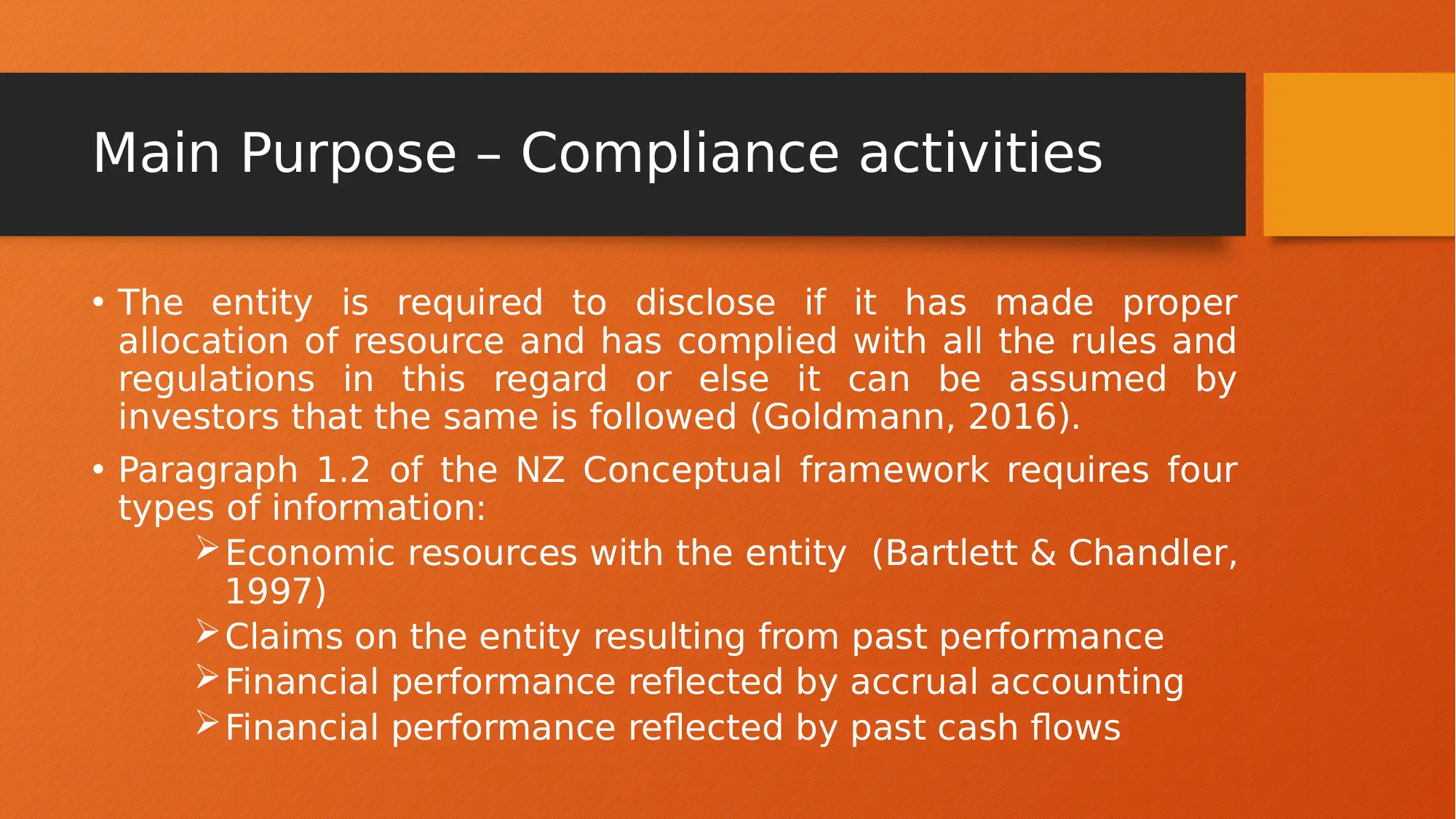
Main Purpose – Compliance activities
• The entity is required to disclose if it has made proper
allocation of resource and has complied with all the rules and
regulations in this regard or else it can be assumed by
investors that the same is followed (Goldmann, 2016).
• Paragraph 1.2 of the NZ Conceptual framework requires four
types of information:
Economic resources with the entity (Bartlett & Chandler,
1997)
Claims on the entity resulting from past performance
Financial performance reflected by accrual accounting
Financial performance reflected by past cash flows
• The entity is required to disclose if it has made proper
allocation of resource and has complied with all the rules and
regulations in this regard or else it can be assumed by
investors that the same is followed (Goldmann, 2016).
• Paragraph 1.2 of the NZ Conceptual framework requires four
types of information:
Economic resources with the entity (Bartlett & Chandler,
1997)
Claims on the entity resulting from past performance
Financial performance reflected by accrual accounting
Financial performance reflected by past cash flows
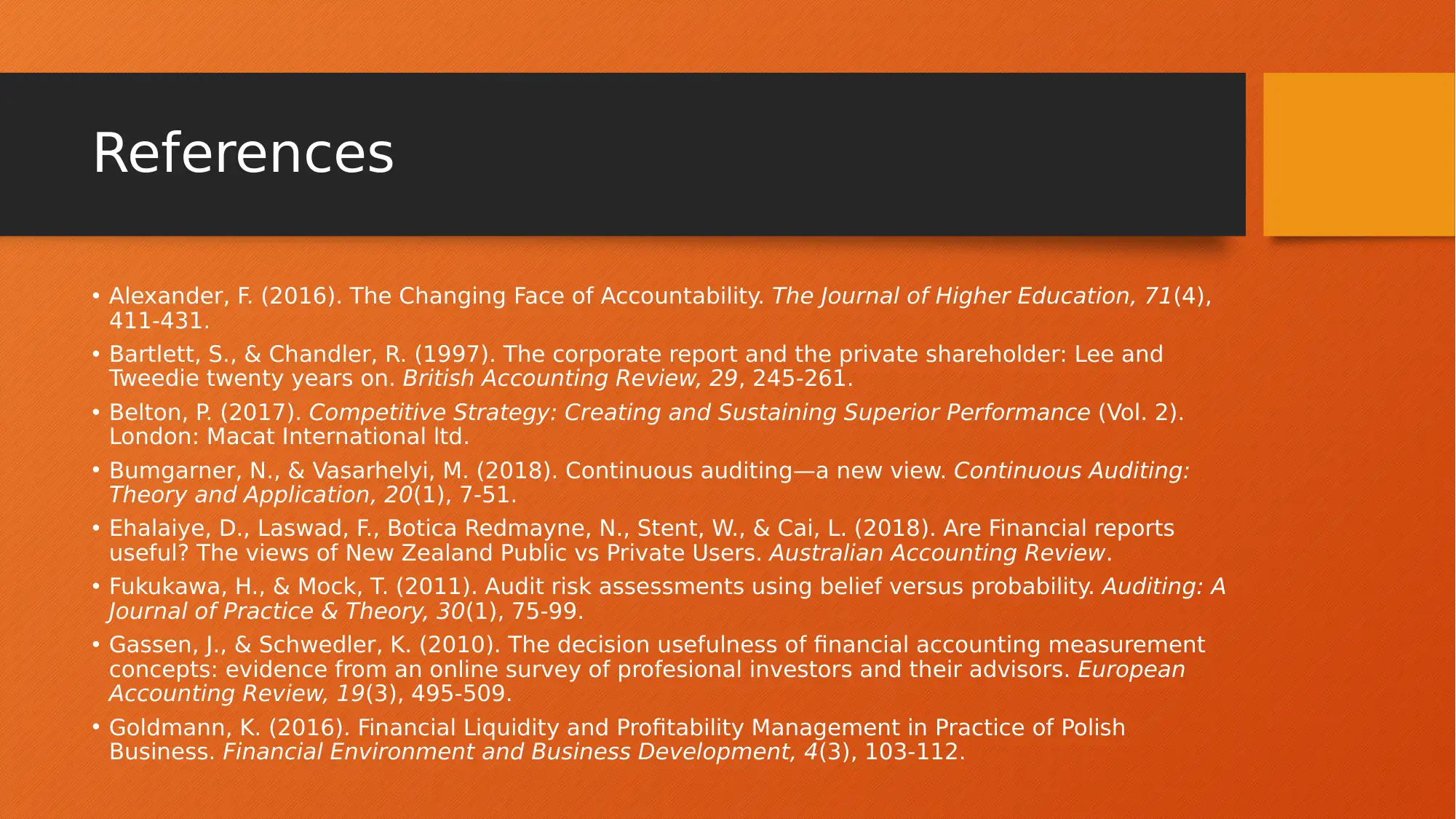
References
• Alexander, F. (2016). The Changing Face of Accountability. The Journal of Higher Education, 71(4),
411-431.
• Bartlett, S., & Chandler, R. (1997). The corporate report and the private shareholder: Lee and
Tweedie twenty years on. British Accounting Review, 29, 245-261.
• Belton, P. (2017). Competitive Strategy: Creating and Sustaining Superior Performance (Vol. 2).
London: Macat International ltd.
• Bumgarner, N., & Vasarhelyi, M. (2018). Continuous auditing—a new view. Continuous Auditing:
Theory and Application, 20(1), 7-51.
• Ehalaiye, D., Laswad, F., Botica Redmayne, N., Stent, W., & Cai, L. (2018). Are Financial reports
useful? The views of New Zealand Public vs Private Users. Australian Accounting Review.
• Fukukawa, H., & Mock, T. (2011). Audit risk assessments using belief versus probability. Auditing: A
Journal of Practice & Theory, 30(1), 75-99.
• Gassen, J., & Schwedler, K. (2010). The decision usefulness of financial accounting measurement
concepts: evidence from an online survey of profesional investors and their advisors. European
Accounting Review, 19(3), 495-509.
• Goldmann, K. (2016). Financial Liquidity and Profitability Management in Practice of Polish
Business. Financial Environment and Business Development, 4(3), 103-112.
• Alexander, F. (2016). The Changing Face of Accountability. The Journal of Higher Education, 71(4),
411-431.
• Bartlett, S., & Chandler, R. (1997). The corporate report and the private shareholder: Lee and
Tweedie twenty years on. British Accounting Review, 29, 245-261.
• Belton, P. (2017). Competitive Strategy: Creating and Sustaining Superior Performance (Vol. 2).
London: Macat International ltd.
• Bumgarner, N., & Vasarhelyi, M. (2018). Continuous auditing—a new view. Continuous Auditing:
Theory and Application, 20(1), 7-51.
• Ehalaiye, D., Laswad, F., Botica Redmayne, N., Stent, W., & Cai, L. (2018). Are Financial reports
useful? The views of New Zealand Public vs Private Users. Australian Accounting Review.
• Fukukawa, H., & Mock, T. (2011). Audit risk assessments using belief versus probability. Auditing: A
Journal of Practice & Theory, 30(1), 75-99.
• Gassen, J., & Schwedler, K. (2010). The decision usefulness of financial accounting measurement
concepts: evidence from an online survey of profesional investors and their advisors. European
Accounting Review, 19(3), 495-509.
• Goldmann, K. (2016). Financial Liquidity and Profitability Management in Practice of Polish
Business. Financial Environment and Business Development, 4(3), 103-112.
⊘ This is a preview!⊘
Do you want full access?
Subscribe today to unlock all pages.

Trusted by 1+ million students worldwide
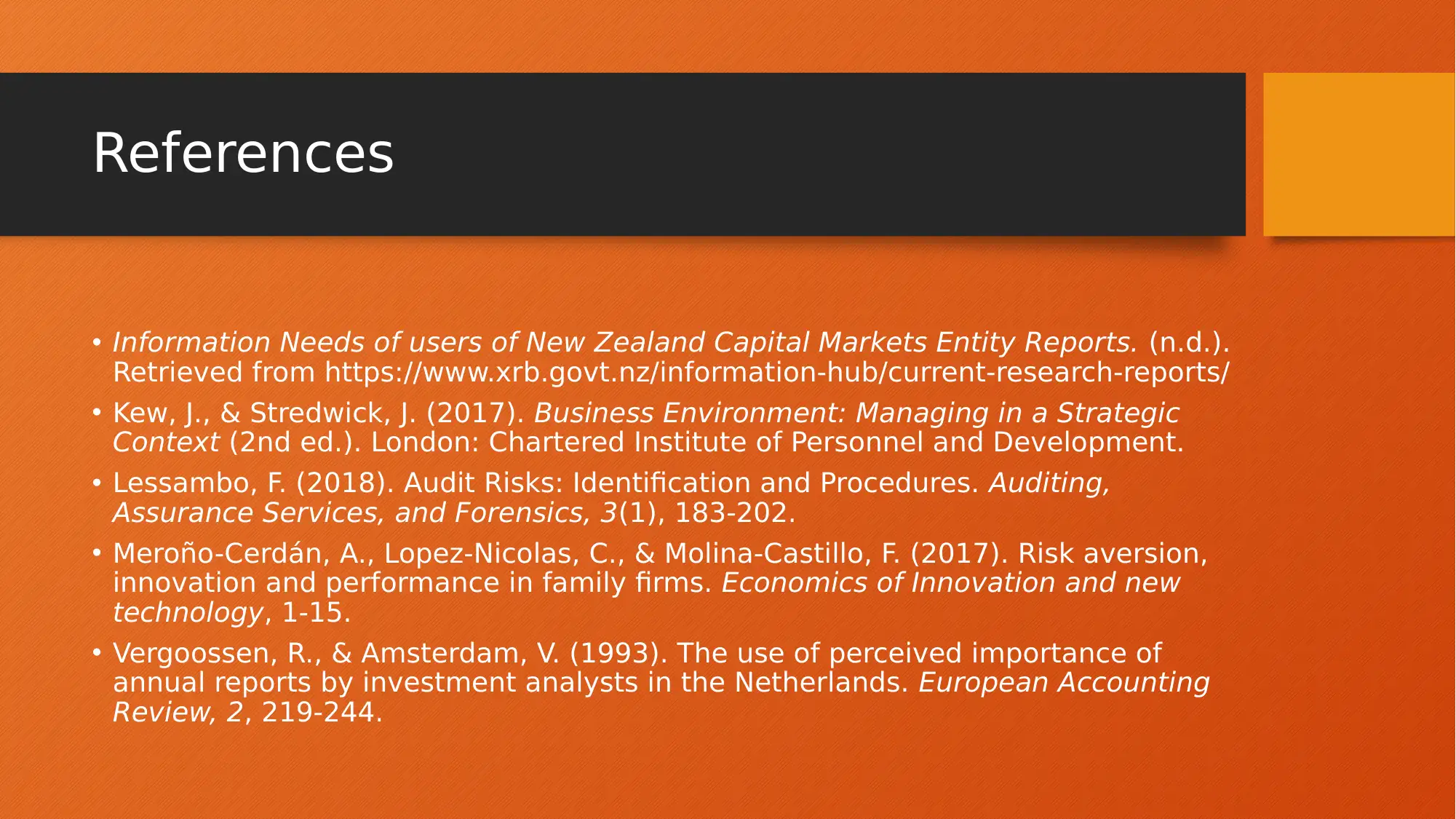
References
• Information Needs of users of New Zealand Capital Markets Entity Reports. (n.d.).
Retrieved from https://www.xrb.govt.nz/information-hub/current-research-reports/
• Kew, J., & Stredwick, J. (2017). Business Environment: Managing in a Strategic
Context (2nd ed.). London: Chartered Institute of Personnel and Development.
• Lessambo, F. (2018). Audit Risks: Identification and Procedures. Auditing,
Assurance Services, and Forensics, 3(1), 183-202.
• Meroño-Cerdán, A., Lopez-Nicolas, C., & Molina-Castillo, F. (2017). Risk aversion,
innovation and performance in family firms. Economics of Innovation and new
technology, 1-15.
• Vergoossen, R., & Amsterdam, V. (1993). The use of perceived importance of
annual reports by investment analysts in the Netherlands. European Accounting
Review, 2, 219-244.
• Information Needs of users of New Zealand Capital Markets Entity Reports. (n.d.).
Retrieved from https://www.xrb.govt.nz/information-hub/current-research-reports/
• Kew, J., & Stredwick, J. (2017). Business Environment: Managing in a Strategic
Context (2nd ed.). London: Chartered Institute of Personnel and Development.
• Lessambo, F. (2018). Audit Risks: Identification and Procedures. Auditing,
Assurance Services, and Forensics, 3(1), 183-202.
• Meroño-Cerdán, A., Lopez-Nicolas, C., & Molina-Castillo, F. (2017). Risk aversion,
innovation and performance in family firms. Economics of Innovation and new
technology, 1-15.
• Vergoossen, R., & Amsterdam, V. (1993). The use of perceived importance of
annual reports by investment analysts in the Netherlands. European Accounting
Review, 2, 219-244.
Paraphrase This Document
Need a fresh take? Get an instant paraphrase of this document with our AI Paraphraser

THANK YOU
1 out of 11
Related Documents
Your All-in-One AI-Powered Toolkit for Academic Success.
+13062052269
info@desklib.com
Available 24*7 on WhatsApp / Email
![[object Object]](/_next/static/media/star-bottom.7253800d.svg)
Unlock your academic potential
Copyright © 2020–2025 A2Z Services. All Rights Reserved. Developed and managed by ZUCOL.





